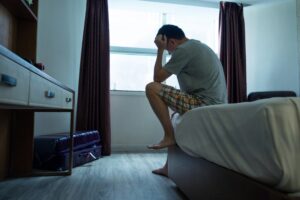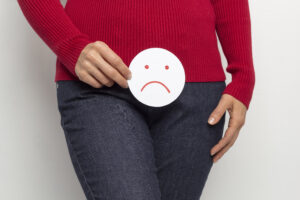It can be confusing, frustrating, anxiety-provoking, and many other emotions when there is a change in your sexual desire. Sexual desire consists of thoughts, fantasies, or urges to become sexual alone or with other(s). Everyone can experience low sexual desire from time to completely normal time. Not everyone experiences desire such as individuals who identify as asexual. This is also normal. This article will be for those who do experience desire, but there has been a change. In this article, we will discuss:
-> Biological, psychological, and social factors that contribute to changes in desire
-> Diagnoses indicative of arousal or desire issues that may benefit from professional help
-> Recommendations for further reading
For some people, these changes can be difficult to admit or to talk about. Society can create a fallacy about the idea that sexual desire is a key part of any relationship and must always be there.
It is more common for women to experience low desire than men, but men can and do as well. There may be instances where one person in a couple of experiences low sexual desire creating a desire discrepancy. This issue is viewed as a problem for the couple and not just for the person with low desire to be identified as the problem to be fixed. Men can have low desire and female partners can also have high desires. This also happens in same-sex relationships. Research suggests that desire discrepancy is the most common sexual issue among couples. One British study indicated that for couples who had been together for at least one year, 27.4% of women and 23.4% of men felt there was an imbalance of sexual desire in their relationship (Mitchell et al., 2013). There are challenges with researching this topic as men and women are studied separately then inferences are made about those results. Not many studies included couples and looked at their relationship as a whole.
What are the possible causes of a decrease in sexual desire?
Our main sexual organ isn’t our genitals, but rather our minds and this is where desire lives. Our genitals may react to the desire you experience in your brain, but not always. Sexual desire is impacted by biological, psychological, and social (biopsychosocial) factors. Many of these are normal and can be experienced at many points in your life. These factors can increase with age as hormones and sexual functioning may change. Let’s review the biopsychosocial factors.
Biological Factors
Chronic illness, aging, physical disabilities/pain, Sexually Transmitted Infections (STIs), and drugs can impact sexual desire. If we don’t feel physically well, then it impacts not only our mood but our desire.
Our brains might be focused on physical discomfort making it challenging to be open to sexual thoughts or fantasies. As we age, we are more susceptible to chronic illness. Cardiovascular and nervous system- related conditions are the most likely to impede sexual functioning and thus desire. As an example, Diabetes can impact sexual functioning in men and women due to its impact on blood flow to the genitals. Additionally, Multiple Sclerosis impacts the nervous system causing challenges with achieving an orgasm. Ultimately, if you don’t feel confident in your genitalia’s ability to feel pleasure and orgasm, some people become less interested in sexual thoughts and behaviors.
Sexual pain can be a symptom of Vaginismus or Dyspareunia. These conditions are treatable and can be managed with the support of pelvic floor therapists and/or sex therapy. Many women struggle with this condition for all kinds of reasons. Some may also have general penetration anxiety perhaps due to a previous painful experience or a belief that it will be painful. If you experience this, you are not alone. Joining an online community for resources and support may be helpful.
Cancer and its treatments can cause problems with sexual function as well as change the parts of one’s body that cause someone to feel desired or experience pleasure. For instance, removing breasts or testicles may cause the person to feel more self-conscious and less sexy therefore impacting his or her motivation to feel desire. Cancer treatments may have temporary or long-term effects on functioning making it difficult to experience pleasure in the same way. It can be difficult to adjust after cancer not just physically, but also psychologically (see next section) creating a barrier to desire. Some people, want to feel sexy and good about themselves to have sexual thoughts and urges.
Sexually Transmitted Infections such as Chlamydia and Gonorrhea can cause pelvic inflammatory issues for women making sex painful and making it difficult to orgasm. Chlamydia and Gonorrhea can cause testicle pain for men ( Lehmiller, 2018). For some people, the possibility of having or due to having an STI in the past causes anxiety that may impact one’s ability to think about or participate in sexual behavior.
Drugs that are legal and illegal can impact sexual desire. A group of medications called SSRIs that are used for anxiety and depression often cause issues with lower libidos and can impede sexual functioning such as getting and maintaining an erection as well as the ability to orgasm. I had someone once refer to Celexa (an SSRI) as “no sexa” because it made her lose interest in sex and when she tried to feel sexual pleasure, she couldn’t achieve an orgasm. For some women, birth control with hormones can impact sexual desire and functioning. Antipsychotics and tranquilizers can impair one’s ability to achieve orgasm (Lehmiller, 2018). Substances such as alcohol, tobacco, and illegal substances may not always have immediate issues but can create longer-term medical conditions that impact sexual functioning and arousal as noted above.
For instance, men who smoke for years are more likely to have erectile issues due to the impact of tobacco on the cardiovascular system (Segraves & Balon, 2003). While being disinhibited by substance, one might initially feel more aroused, but many, they struggle to orgasm.
Many men can have difficulty achieving and maintaining an erection while drinking alcohol. I have met with young men who believe they have erectile issues after trying to have sex unsuccessfully while drunk. This is a normal reaction to alcohol consumption and will go away once he sobers up.
Biological factors potentially increase as you get older due to the higher risk of chronic illness. Medications and other substances play a role in desire and sexual functioning. If someone struggles with their ability to become aroused or orgasm, there is often an issue with desire too. The psychological impact of desire is quite significant for many in addition to the biological factors.
Psychological Factors
Psychological factors have a strong impact on sexual desire as well as functioning. These factors include distraction, previous learning experience, beliefs about sexual behavior, and mental health. Distraction can be thinking about what you will have for dinner or something that happened at work or it can be something called spectatoring (Masters & Johnson, 1970) when you overanalyze your performance. If you are focused on a judgment about how you are doing then you aren’t focused on your pleasure. While orgasm isn’t always the goal of sex, it is also a challenge to enjoy yourself when you are thinking more about whether you did something right or wrong or are pleasing your partner.
What we have learned about sex becomes the lens through which we see and interpret ourselves and others as sexual beings. Childhood messages and experiences impact our beliefs and ideas about sex. For instance, if you grow up thinking sex is shameful or bad unless married you may not be able to experience pleasure in the same way as someone who feels more positively about it. Those who have had bad sexual experiences such as rape, sexual assault, and shaming during sex, may find sex unenjoyable and struggle to engage in it. It is common for men and women to reveal past sexual abuse during sex therapy (McCarthy, 1990).
Our belief about sexual dysfunction and its prevalence can impact how we think about our sexual functioning. If it is thought that sexual dysfunction is prevalent, then one might monitor themselves closely for problems during sex impacting one’s ability to enjoy it. This also creates anxiety and worry or spectatoring as described above.
A lack of knowledge about one’s body and body image issues can cause psychological challenges that impact desire. Particularly for women, a lack of knowledge and understanding about their bodies can impact sexual pleasure and desire. For instance, many women believe that you can only orgasm out of your vagina when most women orgasm by clitoral stimulation. Women can have negative thoughts and feelings about the appearance of their vulva (collective vaginal parts) and breasts, while men can be unhappy about their penis size. This discomfort often causes people to avoid sex or only have it under certain conditions where they cannot see these body parts (ex., under the covers, partially clothes, lights off). These conditions make it challenging to be spontaneous and cause spectatoring due to overthinking about their appearance or focusing on the body part they are unhappy about.
One’s mental health can be an important factor though it may depend on how mood is impacted. Those with a lower mood such as Depression often have lower libido and have a hard time experiencing pleasure in many areas of their life, not just sex. While those with higher moods such as mania, or even hyperactivity as part of ADHD can cause increased libido. Due to medications being used to treat mental health, it can be hard to tease out biological and psychological factors that cause problems with desire.
Social Factors
Many potential social factors contribute to desire issues and sexual challenges that may be a reflection of the current relationship or beliefs you may have from past experiences. Ineffective communication is correlated with lower sexual satisfaction in relationships (Babin, 2013). If you aren’t able to tell your parts what turns you on and off, then it would be challenging to experience sexual pleasure. Further, it makes sense that desire is lower because there wouldn’t be a sense of excitement to do it again. It can be hard to communicate openly about sex. This may be due to relationship conflict or general difficulty talking about sex. Brotto (2010a) said that unresolved relational conflict and anger cause a reduction in sexual desire toward a partner. This can then cause more relationship issues. I have worked with couples with whom they report a desire discrepancy, but the partner with the lower desire has been harboring resentment toward the partner with the higher libido for nonsexual reasons. The problem is that the anger wasn’t spoken about, or it wasn’t resolved despite efforts.
If sex becomes a chore or scheduled activity, it can create an issue with desire. In cases where the couple is trying to have a baby or due to busy work and child schedules sex is scheduled there is less spontaneous and responsive desire. These are situations where it is important to ensure foreplay and other creative approaches to keep the desire and pleasure as a priority.
Some cultures may promote that sexual desire and pleasure isn’t normal. This can be true, particularly for women. Sex may be seen as a means of procreation and something a woman submits to rather than enjoys. Therefore, the desire may not be thought of as an option for some in these cultures.
Further, there can be ideas people develop through various environments such as family, friends, media, or other cultural perspectives that create myths about desire, particularly around perceived gender roles. Sarah Hunter Murray, Ph.D. deconstructed Desire Myths about gender roles: women are only desirable when men do the desiring; men don’t ever want or need to be desired; men notice and “chase women,” but not vice versa. These beliefs can cause misperceptions about oneself and their partner potentially creating desire issues.
The biopsychosocial model provides a lens to see the variety of normative factors that can impact desire. Some of these factors may resolve on their own or with time, while others may need medical or mental health treatment to assist with a return of desire. For women, there is a great book called Come as You Are by Emily Nagoski Ph.D, that talks about managing these factors as well as understanding your body. Unfortunately, there isn’t a male version yet, though there is a lot of information that is gender neutral and would also be helpful to men.
When are these factors a more significant problem?
When these factors start to cause distress that may impede daily functioning, then there may be an issue that would benefit from professional support. For women desire issues and sexual difficulties often occur simultaneously. You can also read our article on When Does Masturbation Become a Problem.
There are two diagnosable conditions: Female Sexual Interest/Arousal Disorder (SIAD) and Male Hypoactive Sexual Desire Disorder (HSDD). Both of these include reduced or no sexual thoughts or fantasies, a lack of desire for sexual activity, and significant distress. SIAD also includes criteria for a lack of sexual excitement before and during sexual activity, less genital sensations during sex, and a lack of responsive desire (DSM-V, 2013). Women used to be able to be diagnosed with both, but this changed in the latest DSM manual. Further, a woman can also be diagnosed with Female Orgasmic Disorder, which reflects a delay in, decrease, or absence of orgasm and/or reduced intensity of orgasms. If one’s orgasm isn’t as satisfying as before, this might cause a decrease in desire and sexual interest. There are treatments for these disorders when done by a trained professional. Creating a closer connection to your body with mindfulness is an effective tool. Read more about it in our article Taking Control of Compulsive Masturbation with Mindfulness. Sex therapists who are AASECT certified have complete extra training and consultation. You can find an AASECT- certified therapist via their directory.
There are many ways desire can be impacted by men and women. Many factors will resolve as situations and perspectives change, while others may need a medical or mental health professional’s assistance. Ultimately, changes in desire can be normal, especially as we age. If you start to feel distressed personally or in your relationship, reach out for support. Sexual Health and Healing may be able to help. See our team page for a list of our providers. Here are some books by experts that may be helpful to read, if you want to learn more on this topic.
Ladies! There is a great research based resource filled with videos, animations, and articles to help women connect with their pleasure. This info was created from the sexual discoveries of 20,000 women and in collaboration with Yale University, The Kinsey Institute, and Indiana University. There is so much information on the internet that it can be hard to know who to trust. OMG YES is a trusted resource!
Book Recommendations
Come as You Are by Emily Nagoski, Ph.D








